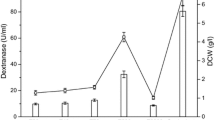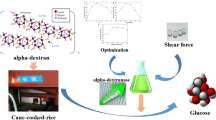Abstract
Dextransucrase is the enzyme that catalyzes the synthesis of dextran from sucrose. Though dextran is an unwanted deterioration product in the sugar industry, it is being widely used in medicine, cosmetics, and several food areas. Currently, the natural enzyme activity of dextransucrase is low. Thus, it is of great interest to understand how to improve the dextransucrase activity. In the study, Leuconostoc mesenteroides (L.M.CICC-20724) were cultured in a glucose-based solid medium (glucose was the sole carbon source) and then transferred to a sucrose-based solid medium (sucrose was the sole carbon source) for rejuvenation. It was observed that the dextransucrase production was inhibited when L.M.CICC-20724 using the glucose-based solid medium. After 3 months of acclimation, the activity of dextransucrase produced by the acclimated L. mesenteroides (Glu-L.M.) achieved a stable level at approximately 4.20 U/mL. The dextransucrase activity (approximately 1–2 U/mL) increased more than two times with L.M.CICC-20724 in comparision with original one. Dextran products generated from Glu-L.M. and L.M.CICC-20724 were studied using Fourier transform infrared spectroscopy and results showed that both dextrans had a consistent structural composition. The kinetics of sucrose consumption was studied. Under the condition of 0.5 U/mL dextransucrase activity, the consumption of relative low initial sucrose concentrations (0.1, 0.2 and 0.4 M) more fitted to the first-order reaction kinetics, while the consumption of relative high initial sucrose concentrations (0.6 and 0.8 M) was fitted better to the second-order reaction kinetics.








Similar content being viewed by others
References
Ball, D. 1998. Kinetics of consecutive reactions: First reaction, first-order; second reaction, zeroth order. Journal of Chemical Education 75 (7): 917–919.
Bao, Y., H. Yang, L. Jing, Z. Li, and Y. Jiang. 2011. Amino acid composition, molecular weight distribution and antioxidant activity of protein hydrolysates of soy sauce lees. Food Chemistry 124 (2): 551–555.
Boeker, E.A. 1984. Integrated rate equations for enzyme-catalysed first-order and second-order reactions. Biochemical Journal 223 (1): 15–22.
Cao, W., X.Q. Li, L. Liu, T.H. Yang, C. Li, H.T. Fan, M. Jia, Z.G. Lu, and Q.B. Mei. 2006. Structure of an anti-tumor polysaccharide from Angelica sinensis (Oliv.) Diels. Carbohydrate Polymers 66 (2): 149–159.
Demuth, K., H.J. Jördening, and K. Buchholz. 2002. Oligosaccharide synthesis by dextransucrase: New unconventional acceptors. Carbohydrate Research 337 (20): 1811–1820.
Eom, H.J., D.M. Seo, and N.S. Han. 2007. Selection of psychrotrophic Leuconostoc spp. producing highly active dextransucrase from lactate fermented vegetables. International Journal of Food Microbiology 117 (1): 61–67.
Ghai, K., S.K. Batta, G.S. Kocher, and A.K. Gupta. 2015. production, partial purification and kinetic characterization of dextransucrase from Leuconostoc mesenteroides in relation to dextran problem in sugarcane. Sugar Tech 17 (2): 1–11.
Hemme, D., and C. Foucaud-Scheunemann. 2004. Leuconostoc, characteristics, use in dairy technology and prospects in functional foods. International Dairy Journal 14 (6): 467–494.
Ioan, C.E., T. Aberle, and W. Burchard. 2000. Structure properties of dextran. 2. Dilute solution. Macromolecules 33 (15): 5730–5739.
Jašo, V., D.Cacute Stoiljkovi, Ccaronevi Radi, R. Cacute, and O. Bera. 2013. Kinetic modeling of bulk free-radical polymerization of methyl methacrylate. Polymer Journal 45 (6): 631–636.
Jin, Q., L. Li, Y.J. Kim, and N.S. Han. 2014. Construction of a dextran-free Leuconostoc citreum mutant by targeted disruption of the dextransucrase gene. Journal of Applied Microbiology 117 (4): 1104–1112.
Kitaoka, M., and J.F. Robyt. 1999. Mechanism of the action of Leuconostoc mesenteroides B-512FMC dextransucrase: Kinetics of the transfer of d-glucose to maltose and the effects of enzyme and substrate concentrations. Carbohydrate Research 320 (3–4): 183–191.
Kralj, S., I.G. van GeelSchutten, E.J. Faber, V.D.M. Mj, and L. Dijkhuizen. 2005. Rational transformation of Lactobacillus reuteri 121 reuteransucrase into a dextransucrase. Biochemistry 44 (25): 9206–9216.
Liu, C., Q. Lin, Y. Gao, L. Ye, Y. Xing, and T. Xi. 2007. Characterization and antitumor activity of a polysaccharide from Strongylocentrotus nudus eggs. Carbohydrate Polymers 67 (3): 313–318.
Malten, M., R. Hollmann, W.-D. Deckwer, and D. Jahn. 2005. Production and secretion of recombinant Leuconostoc mesenteroides dextransucrase DsrS in Bacillus megaterium. Biotechnology and Bioengineering 89 (2): 206–218. doi:10.1002/bit.20341.
Monchois, V., R.M. Willemot, M. Remaud-Simeon, C. Croux, and P. Monsan. 1996. Cloning and sequencing of a gene coding for a novel dextransucrase from Leuconostoc mesenteroides NRRL B-1299 synthesizing only α(1–6) and α(1–3) linkages. Gene 182 (1–2): 23–32.
Naessens, M., A. Cerdobbel, W. Soetaert, and E.J. Vandamme. 2005. Leuconostoc dextransucrase and dextran: Production, properties and applications. Journal of Chemical Technology and Biotechnology 80 (8): 845–860.
Neely, W.B., and J. Nott. 1962. Dextransucrase, an induced enzyme from Leuconostoc mesenteroides. Biochemistry 1 (6): 1136–1140.
Paluszkiewicz, C., E. Stodolak, M. Hasik, and M. Blazewicz. 2011. FT-IR study of montmorillonite–chitosan nanocomposite materials. Spectrochimica Acta Part A: Molecular and Biomolecular Spectroscopy 79 (4): 784–788.
Parlak, M., D. Ustek, and A. Tanriseven. 2014. Designing of a novel dextransucrase efficient in acceptor reactions. Carbohydrate Research 386: 41–47.
Paul, F., D. Auriol, E. Oriol, and P. Monsan. 2006. Production and purification of dextransucrase from Leuconostoc mesenteroides, NRRL B 512 (F). Annals of the New York Academy of Sciences 434 (1): 267–270.
Pu, Y., Q. Zou, D. Hou, Y. Zhang, and S. Chen. 2017. Molecular weight kinetics and chain scission models for dextran polymers during ultrasonic degradation. Carbohydrate Polymers 156: 71–76.
Purama, R.K., P. Goswami, A.T. Khan, and A. Goyal. 2009. Structural analysis and properties of dextran produced by Leuconostoc mesenteroides NRRL B-640. Carbohydrate Polymers 76 (1): 30–35.
Purama, R.K., and A. Goyal. 2008a. Identification, effective purification and functional characterization of dextransucrase from Leuconostoc mesenteroides NRRL B-640. Bioresource Technology 99 (9): 3635–3642.
Purama, R.K., and A. Goyal. 2008b. Screening and optimization of nutritional factors for higher dextransucrase production by Leuconostoc mesenteroides NRRL B-640 using statistical approach. Bioresource Technology 99 (15): 7108–7114.
Quirasco, M., A. Lópezmunguía, M. Remaudsimeon, P. Monsan, and A. Farrés. 1999. Induction and transcription studies of the dextransucrase gene in Leuconostoc mesenteroides NRRL B-512F. Applied and Environmental Microbiology 65 (12): 5504–5509.
Richard, G., S. Morel, R.M. Willemot, P. Monsan, and M. Remaudsimeon. 2003. Glucosylation of alpha-butyl- and alpha-octyl-d-glucopyranosides by dextransucrase and alternansucrase from Leuconostoc mesenteroides. Carbohydrate Research 338 (9): 855–864.
Robyt, J.F., S.H. Yoon, and R. Mukerjea. 2008. Dextransucrase and the mechanism for dextran biosynthesis. Carbohydrate Research 343 (18): 3039–3048.
Rodina, N.N., V.V. Shutova, and V.V. Revin. 2015. Effect of sucrose on the growth and dextransucrase activity of Leuconostoc mesenteroides. Journal of Biotechnology 208: S117–S117.
Santos, M., J. Teixeira, and A.R. Rodrigues. 2000. Production of dextransucrase, dextran and fructose from sucrose using Leuconostoc mesenteroides NRRL B512(f). Biochemical Engineering Journal 4 (3): 177–188.
Siddiqui, N.N., A. Aman, A. Silipo, S.A.U. Qader, and A. Molinaro. 2014. Structural analysis and characterization of dextran produced by wild and mutant strains of Leuconostoc mesenteroides. Carbohydrate Polymers 99 (1): 331–338.
Silvestri, M.G. 1989. A kinetic study of the Diels–Alder reaction: An experiment illustrating simple second-order reaction kinetics. Journal of Chemical Education 66 (66): 690.
Tsuchiya, H.M., H.J. Koepsell, J. Corman, G. Bryant, M.O. Bogard, V.H. Feger, and R.W. Jackson. 1952. The effect of certain cultural factors on production of dextransucrase by Leuconostoc mesenteroides. Journal of Bacteriology 64 (4): 521–526.
Vettori, M.H.P.B., R. Mukerjea, and J.F. Robyt. 2011. Comparative study of the efficacies of nine assay methods for the dextransucrase synthesis of dextran. Carbohydrate Research 346 (9): 1077–1082.
Zannini, E., D.M. Waters, and E.K. Arendt. 2014. The application of dextran compared to other hydrocolloids as a novel food ingredient to compensate for low protein in biscuit and wholemeal wheat flour. European Food Research and Technology 238 (5): 763–771.
Zhang, H., Y. Hu, C. Zhu, B. Zhu, and Y. Wang. 2008. Cloning, sequencing and expression of a dextransucrase gene (dexYG) from Leuconostoc mesenteroides. Biotechnology Letters 30 (8): 1441–1446. doi:10.1007/s10529-008-9711-8.
Zou, Q., Y. Pu, Z. Han, N. Fu, S. Li, M. Liu, L. Huang, A. Lu, J. Mo, and S. Chen. 2012. Ultrasonic degradation of aqueous dextran: Effect of initial molecular weight and concentration. Carbohydrate Polymers 90 (1): 447–451.
Acknowledgements
This work was financially supported by National Natural Science Foundation of China (21264003) and Collaborative Innovation Center for Guangxi Sugar Industry.
Author information
Authors and Affiliations
Corresponding author
Ethics declarations
Conflict of interest
The authors declare that they have no conflict of interest.
Rights and permissions
About this article
Cite this article
Hou, DZ., Pu, YY., Zou, QS. et al. Improvement of Dextransucrase Activity by Glucose Acclimation Cultivation and Kinetics of Sucrose Consumption. Sugar Tech 20, 60–68 (2018). https://doi.org/10.1007/s12355-017-0534-6
Received:
Accepted:
Published:
Issue Date:
DOI: https://doi.org/10.1007/s12355-017-0534-6




